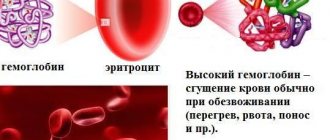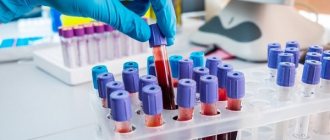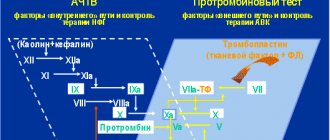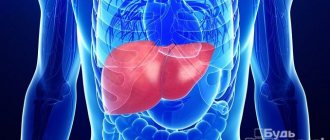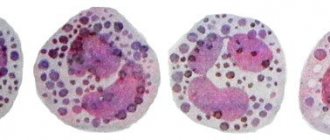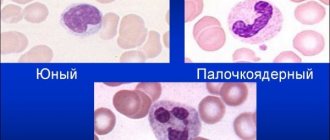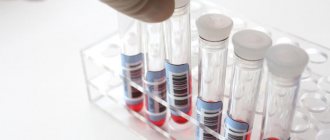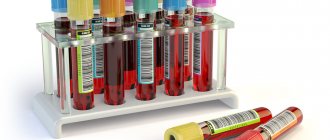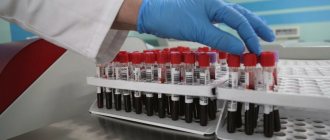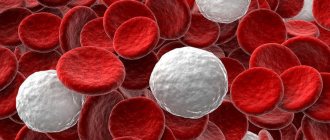A biochemical blood test allows you to evaluate the functioning of internal organs. One of the leading indicators of this study is total blood protein (total protein).
An indicator of total blood protein and amino acid metabolism, which characterizes the level of protein molecules of all types and fractions in the blood serum. By the concentration of proteins you can find out how protein metabolism occurs.
Proteins perform a variety of functions and ensure the normal functioning of the body. If the total protein in the blood is low, then the cause of this may be dangerous pathologies. Therefore, this condition requires timely and competent treatment.
What is hypoalbuminemia?
Albumin structure
Hypoalbuminemia (HA) is a condition in which the main blood plasma protein albumin is reduced. HA develops unnoticed and can lead to serious consequences, so it is important to identify the pathology as early as possible.
Albumin is a simple protein consisting of 585 amino acid residues. The oncotic pressure of the plasma depends on its concentration, that is, the protein is involved in regulating the passage of fluid through the capillary wall. With HA, due to a lack of albumin, fluid accumulates in the intercellular space, which is manifested by edema.
The albumin molecule contains many reactive sites, thanks to which the protein easily binds and transports substances necessary for the body: fatty acids, calcium, magnesium, chlorine, bile acids, bilirubin, vitamins, hormones, and medications. In case of GA, the usual intake of medications can lead to intoxication, since albumin does not effectively perform its function of delivering them to the detoxification organs. Albumin is a central participant in the body's detoxification system. It is able to bind to heavy metal ions and toxic waste products, promoting their elimination. With GA there is a sharp increase in the toxicity index.
Albumin synthesis occurs in the liver, producing about 12 g of protein daily. With increasing needs of the body, for example, with a decrease in osmotic pressure, the process of albumin formation accelerates. But as a result of various diseases, liver hepatocytes are not able to produce enough protein molecules or the rate of albumin breakdown exceeds the rate of its synthesis.
What types of proteins are there and why are they needed?
There are two main protein fractions in blood serum - albumins and globulins. There are more albumins than globulins, and when protein in the blood is low, this is, first of all, a decrease in albumins. Then the doctors say: “the patient has hypoalbuminemia.” All albumins are synthesized in liver tissue from food amino acids. Food proteins that enter the stomach are not suitable for use in their entirety. First, they need to be broken down into amino acids, and then the body’s own proteins must be synthesized again. It is albumins that create oncotic and osmotic pressure, which retains fluid in blood vessels and tissues and prevents edema from developing.
Globulins have nothing to do with the liver. Their synthesis occurs in peripheral blood cells - lymphocytes. Lymphocytes are immunocompetent cells and their task is to synthesize protective antibodies. A fairly large fraction of globulins regulates blood clotting, since fibrinogen consists of it. Globulins are also coenzymes, various transport carrier proteins and hormones.
In addition to the above functions, proteins form a special reserve. If a person is starving, then proteins that have recently formed are easily broken down into their original amino acids, so that they can then be synthesized again, in vital organs. First of all, these are the brain and myocardium.
Therefore, if a person has low protein in the blood, then, as a rule, all participants in protein metabolism suffer.
Causes of low blood protein
Heart disease may cause hypoalbuminemia
- Impaired albumin formation in liver diseases: cirrhosis, tumors, hepatitis, hepatosis.
- Decreased protein synthesis due to chronic and acute heart failure.
- Impaired protein absorption due to endocrine disorders, inflammatory processes in the intestines, exocrine pancreatic insufficiency.
- Accelerated breakdown of albumin as a result of infectious infections, extensive injuries and burns, rheumatic pathologies, sepsis.
- Increased protein loss in nephrotic syndrome, characterized by damage to the glomerular apparatus of the kidneys.
- Impaired glomerular filtration of the kidneys as a result of damage to the renal blood vessels in diabetes mellitus.
- Insufficient protein intake during strict diets and fasting.
- In newborns, the cause of HA may be immaturity of liver cells.
- Pregnancy.
How does hypoalbuminemia manifest?
Protein edema is a sign of protein loss
HA provokes a chain of pathological processes in the body, the first manifestations of which are most often swelling of the lower extremities. Protein-free edema is soft to the touch; it can be either an independent violation of the water balance or a manifestation of nephrotic syndrome or ascites, which develop against the background of GA. Swelling gradually covers the lumbar region, face, eyelids, spreading throughout the body. This condition is typical for damage to the glomerular capillaries of the kidneys. With developing ascites, fluid gradually accumulates in the abdominal cavity, which, in addition to swelling, manifests itself as abdominal pain, heartburn, shortness of breath, and difficulty breathing.
Since albumin is synthesized in the liver, pathologies of this organ are the first to be suspected in HA and are the most common causes of decreased protein levels. One of the manifestations is the above-mentioned ascites, and there are also feelings of general malaise, fatigue and drowsiness. The liver does not have nerve endings, so a pain symptom is formed already at the stage of organ enlargement, when the gland tissue is stretched and the nerve fibers of the connective capsule on the surface of the liver are affected. Signs of pathological phenomena can be: intestinal upset, vomiting, redness of the palms, yellowed whites of the eyes, sallow skin color, spider veins, itchy skin.
With HA, protein may appear in the urine
The appearance of protein in the urine is a characteristic phenomenon in GA, the cause of which lies in kidney disease. When the glomeruli of the kidneys are damaged, albumin penetrates through their membrane, which leads to protein loss and further development of the disease. Proteinuria gradually develops, with protein released in the urine > 3 g/l.
If the cause of HA lies in other diseases, the symptoms include characteristic signs of the corresponding pathology: shortness of breath, swelling, increased fatigue, dizziness, dry cough due to heart failure; undulating fever, profuse sweating and low blood pressure in sepsis; frequent and excessive urination, unquenchable thirst, prolonged wound healing process in diabetes mellitus, etc.
Why is low protein dangerous?
Low protein negatively affects liver function
GA leads to a decrease in oncotic pressure. As a result, water rushes into the tissue, and swelling of the subcutaneous tissue forms. Dysregulation of water metabolism is accompanied by changes in natural blood circulation. Stagnation of fluid is dangerous for the development of edema of internal organs.
GA is one of the causes of hypocalcemia - a decrease in the level of calcium in the blood plasma. This condition provokes disturbances in nerve conduction of muscles, blood clotting, and metabolic processes.
GA directly affects the development of parenchymal, hemolytic and subhepatic jaundice. Bilirubin, formed during the destruction of hemoglobin, binds to albumin, forming a complex. A decrease in protein leads to the formation of free bilirubin, which provokes an increase in the concentration of bilirubin in the blood. As this process develops, it affects hepatocytes; blockage of the hepatic duct with stones from bilirubin along with blood clots from bile, cholesterol and calcium can form.
A decrease in albumin levels leads to endogenous intoxication, which negatively affects the adaptive properties of the body, immunity, the physicochemical state of the intercellular substance, humoral and nervous regulation of cells.
Protein analysis: indications, preparation
Kidney pathology may be an indication for analysis.
A protein level test is prescribed in the following cases:
- edema syndrome;
- liver diseases;
- kidney pathologies;
- diseases of the digestive tract;
- eating disorders;
- extensive injuries, burns;
- assessment of protein metabolism, liver functionality, nutritional status.
When preparing for analysis, you should consider the rules.
- The day before the test, limit physical and emotional stress, eliminate alcohol.
- The last meal should be completed 12 hours before blood collection.
- On the day of the test, do not drink coffee or tea; you can drink clean water in small quantities.
- Smoking should be avoided at least one hour before the test.
- The results of the analysis are affected by medications: immunosuppressants, barbiturates, glucocorticosteroids, oral contraceptives and many other drugs. If it is impossible to cancel their appointment, the entire list must be provided to the doctor.
Diagnostics and norms of the indicator
Blood serum tests to assess protein concentration are carried out to diagnose pathologies, monitor the dynamics of treatment, prevent diseases, and during the follow-up of pregnant women.
Indications for testing the level of total protein are:
- Joint diseases.
- Assessing the results of patient treatment after burns.
- Prevention of gestosis in the second half of pregnancy.
- Diseases of the cardiovascular system.
- Suspicion of an oncological process.
- Pathological processes in the liver (presence of hepatitis, including viral ones).
- Chronic kidney diseases (pyelonephritis, glomerulonephritis, chronic renal failure).
- General exhaustion of the body due to excessive weight loss (anorexia, cancer cachexia).
- Diagnosis and dynamics of treatment of acute or chronic infectious diseases.
- Preparing for the study:
- Do not eat 10-12 hours before the test.
- Donate blood in the morning.
- Avoid protein foods 4-5 days before the test.
- Do not take medications on the day of the test. The exception is drugs that are vital for the patient.
- Avoid physical activity the day before the test.
- Do not drink alcohol or smoke before taking the test.
- Do not drink coffee, tea, or juices on the day of the study. You can only drink still water.
- If you have symptoms of an infectious disease, inform your doctor or nurse at the medical facility.
Venous blood is taken for analysis. This analysis is called biochemical; its results are used to evaluate the level of biological substances in the body.
The time it takes to receive results varies depending on the medical facility. Biochemical analysis takes 4 to 7 days to prepare. Indicators can change not only with the development of pathological processes, but also for physiological reasons.
These include:
- Environmental impact (sharp climate change, too hot or, conversely, cold weather).
- Floor.
- Genetic predisposition.
- Long sleep.
- Nutrition.
- Physical exercise.
- Pregnancy.
In an adult
Total protein is low in the blood (the reasons for this in adults can be numerous) under the influence of the following factors:
- Chronic diseases.
- Hormonal background.
- Physical exercise.
- Malnutrition.
For an adult, the normal value of protein in the blood is from 66 to 83 g/l. In people over 65 years of age, protein levels range from 60 to 80 g/l. Indicators may vary depending on age and gender. In women, protein levels may depend on the activity of hormones.
In children
In children, a decrease in total protein may be a physiological phenomenon that does not require any treatment. With age, these indicators are adjusted and return to normal.
The indicators by age are as follows:
- Newborns 35-60.
- Children under 1 year 50-65.
- Children from 1 to 2 years old 55-70.
- Children from 2 to 14 years old 65-80.
Fluctuations in total protein in children may indicate acute infections and kidney disease. These pathologies are most common in this age group. If there are changes in the blood test, a thorough diagnosis and treatment of the cause is carried out.
In pregnant women
A biochemical blood test is a mandatory test during pregnancy. With its help, you can identify deviations from the norm that can lead to complications in the health of the mother or fetus.
A blood test is carried out once a month when visiting a antenatal clinic, as well as when pathological conditions are detected (detection of protein in the urine, presence of edema). Normally, the level of total protein in the blood of pregnant women ranges from 64 to 80 g/l.
During pregnancy, a decrease in protein in the blood is very common. As a rule, this should not be alarming if the decrease is small.
Most often, a decrease in total protein occurs in the 1st trimester of pregnancy, since during this period the woman’s body is just beginning to adapt to its new state. Often women experience toxicosis in the first half of pregnancy in the period from 5 to 16 weeks. The pregnant woman is worried about nausea and vomiting, food intake is disrupted.
There may also be a decrease in total protein in the 3rd trimester, due to the increased load on the body. During this period, special attention should be paid to the condition, as the load on the kidneys increases. Often women after 30 weeks develop gestational pyelonephritis.
This is a condition in which the passage of urine is disrupted due to stenosis of the ureter in an older child. Because of this, intense inflammation develops, in which the amount of protein in the urine increases and in the blood decreases.
But there are pathologies in which hypoalbuminemia is a serious symptom. A decrease in protein is observed with gestosis. This is a dangerous complication of pregnancy, which can lead to the development of preeclampsia and eclampsia. With the development of gestosis, an increase in protein is observed in the urine, and its concentration in the blood, on the contrary, is low.
A decrease in indicators is observed with an unbalanced diet and toxicosis. Often a woman cannot eat properly due to constant nausea or vomiting. This condition can be corrected with medication or diet.
Hyperalbuminemia during pregnancy is observed during acute infectious processes and dehydration.
Low protein during pregnancy
During pregnancy, protein levels decrease
During the period of bearing a child, the concentration of protein in the blood decreases, especially for the albumin fraction. Beginning in the second trimester, the blood becomes less viscous to ensure optimal placental perfusion. The decrease in viscosity occurs due to physiological hemodilution, that is, an increase in the volume of circulating blood and an increase in its fluidity. Plasma volume in pregnant women increases to 50% of the original, which is reflected by a reduced protein concentration.
Also, a decrease in the albumin fraction is facilitated by the body’s increased need for amino acids, which are deposited in albumin. Another reason for a decrease in albumin levels is the need to reduce oncotic pressure to facilitate the transfer of nutrients from the mother to the fetus.
However, the reduction should not be below a certain level. The norm of albumin in the normal state is 34 - 42 g/l. For pregnant women it is:
- I trimester - 32 g/l;
- II trimester - 28 g/l;
- III trimester - 24 g/l.
A little about proteins
It is known that metabolism can be energetic and plastic. Plastic metabolism consists of the exchange of proteins, fats, and carbohydrates. Proteins are the most important structural elements of the body, and the total amount of proteins in the serum quickly shows the doctor the state of protein metabolism.
If you take whole blood, centrifuge it, and then take the plasma separately and evaporate it, you will get a dry residue; it will be approximately 10% of the former plasma volume. So, the total protein in the dry residue will be approximately from 6.5% to 8.5% of the mass. This goes very well with the protein norm, which for an adult is from 64 to 83 g per liter.
Proteins are the building material for all structures of the body. All enzymes, which speed up chemical reactions millions of times, are made of proteins. Therefore, low protein in the blood means a decrease in the rate of chemical reactions. Proteins make up hormones, antibodies that fight infections, and blood clotting factors. Therefore, if the total protein is low, then there may be problems with clotting.
A variety of proteins function as transporters, or carriers of many compounds. In connection with proteins, minerals and hormones, vitamins and fats are transported, both in the extracellular fluid and inside cells. Protein systems regulate blood osmosis. It is the oncotic pressure of proteins that does not allow water from tissues to rush into the vessels, and vice versa: this process is under the control of proteins.
Therefore, if a person has low total protein in the blood for a long time, then he experiences peripheral edema, this is exactly what happens during prolonged fasting. As they say, a person “swells from hunger.” Protein systems determine tissue elasticity, as well as acid-base balance, using a protein buffer system. Finally, if a person is starving, consciously or forcedly, then after the animal starch glycogen in the liver runs out, after the free fats run out, then it is proteins that begin to be a source of energy during malnutrition.
Low Protein Diet
The diet should be enriched with protein
To increase protein levels, you need a complete, varied diet, which necessarily includes proteins of both plant and animal origin. Different groups of proteins differ in the composition of amino acids, each of which is necessary for the body. If the cause of GA is fasting or a protein-free diet, the introduction of protein should be gradual.
- Animal proteins: meat, seafood, dairy and fermented milk products, eggs.
- Plant proteins: legumes, nuts, seeds.
For optimal absorption, proteins must be combined with vegetables, as well as the right fats. For example, it would be useful to include in your diet salads of fresh vegetables with boiled chicken or fish fillet, seasoned with olive and sesame oil.
Protein Analysis: Breakdown
Expert opinion
Cardiologist Grigory Viktorovich
Before you raise protein, you need to understand the reasons for its decrease. This can only be determined through a comprehensive examination, which may include x-rays, magnetic resonance and computed tomography, ultrasound, etc. A blood test for the presence and concentration of its other components is also necessary. Their balance will allow us to determine the location of the disease.
Despite the fact that the reason for the decrease in protein may not be pathology, but physiology, you need to increase protein very carefully. If the body is unaccustomed to a diet rich in proteins, then a sudden transition to a protein diet can cause digestive problems.
Attention! A diet with reduced total protein should be prepared by a specialist after a comprehensive examination. In this way, the risk of the body not accepting proteins can be minimized.
The first rule of diet is variety. You can’t rely heavily on any one type of product. Proteins can be found in animal and plant foods. However, scientists have found that proteins of animal origin are absorbed better. A proper diet for hypoproteinemia should include seafood, low-fat dairy products, poultry, and beef. As well as vegetable protein: dark chocolate, nuts (especially almonds and peanuts), wholemeal bread.
